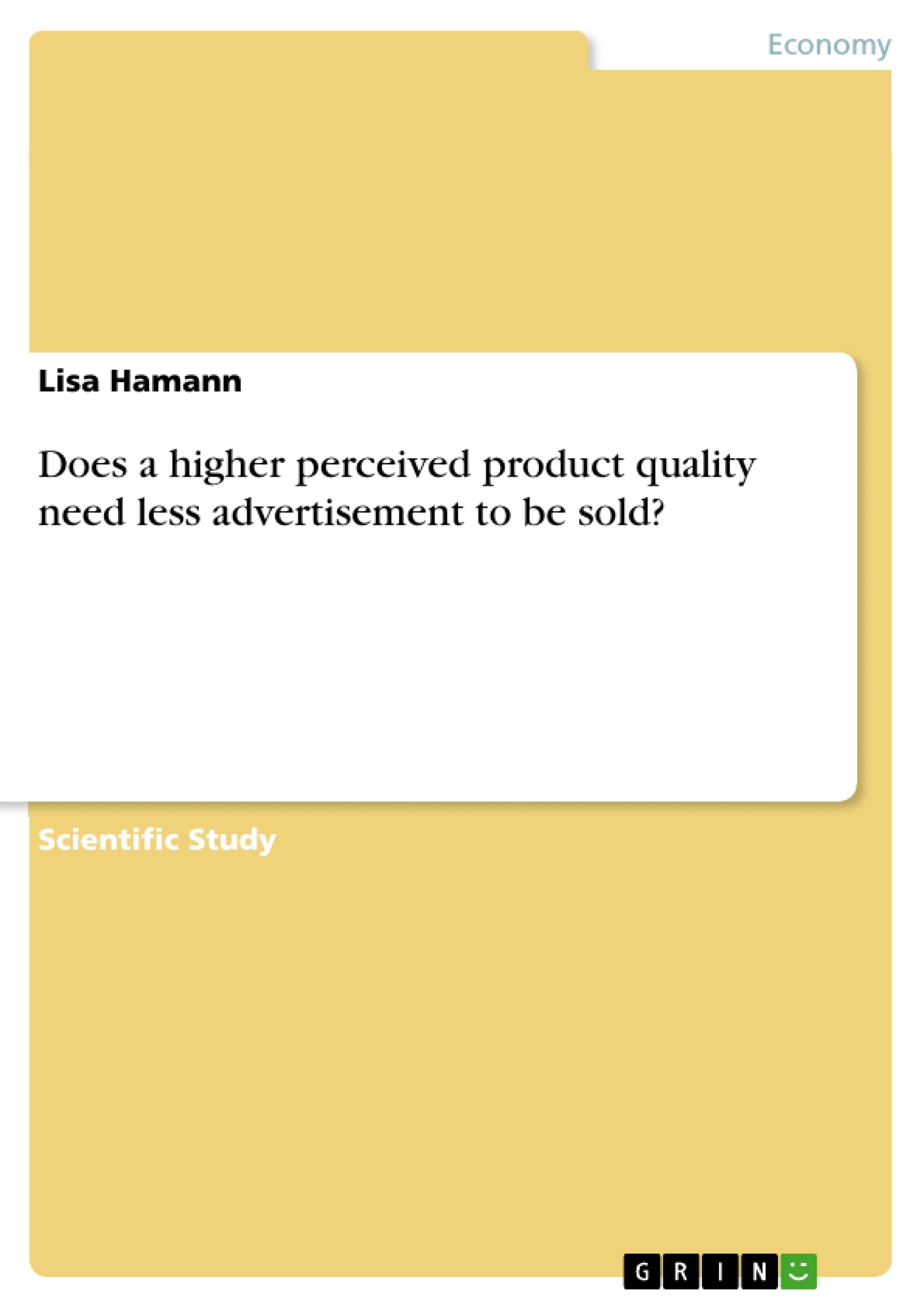Excerpt
Table of Content
Table of Figures
Abstract
1. Introduction
2. Quality
2.1 Definition
2.2 Importance
2.3 Cost of producing quality
3. Seal of quality
3.1 Origin
3.2 Function
3.3 “Stiftung Warentest”
3.3.1 History
3.3.2 Facts, Figures and Financing
3.3.3 Example “Sun lotions”
3.4 ICRT (International Consumer Research and Testing Ltd.)
4. Brands, Quality & Advertisement
5. Own empirical finding – Experiment
5.1. Presentation of products
5.2 Data interpretation
6. Conclusion
7. Bibliographie
8. Affidavit
Table of Figures
Fig. 1: Quality Seal - DIN certified
Fig. 2: tested emblem
Fig. 3: test winner - Sun Ozon
Fig. 4: ICRT
Fig. 6: New Yorker
Fig. 5: Dior
Fig. 7: Nokia 5310 Xpress Music
Abstract
In this scientific paper, it is about to prove that higher perceived product quality needs less advertisement to be sold.
The reader will find theoretical sources as well as an own empirical finding. In this the effect of “Stiftung Warentest” on the customers purchase decision will be proved. At the end, it comes out that customer’s decision for or against a product is also depends on seals of quality – even if they never heard about this product before.
That means if a product reaches good test results (e.g. in a product test about sun lotions by Stiftung Warentest), sales should increase while displaying that seal of quality on the package – true to the motto: good products sell themselves.
1. Introduction
For the consumer it’s not always an easy way to keep track of all wide ranges of different products. A survey of Stiftung Warentest demonstrates that the seal of quality enjoys a great popularity among customers.[1] They should provide them with confidence on supplier’s products.
This paper will help to understand the meaning of seals of quality and the importance of Stiftung Warentest. It will explain the internal action of Stiftung Warentest and inform about employer’s opinion on the mentioned enterprise.
The hypothesis, which forms the basis of this paper, is as follows: The higher the quality of a product perceived by the customer, the less advertisement is required to sell it. It can be assumed that due to quality seals as an independent indicator for product quality (displayed on products), advertisement wouldn’t be necessary anymore.
This paper will start with explaining the importance of the word quality and everything what relates to that theme. Afterwards it will tell about seals of quality and the most popular example for Germany, called Stiftung Warentest. At the end an own empirical finding will be presented, a final summary will complete the paper.
2. Quality
(lat.: qualitas = composition, attribute, character, condition)[2]
Nowadays the functionality of a product is irrevocably connected to its quality.
The meaning, importance and costs of producing are pointed out in order to show the significance of quality.
2.1 Definition
One can find many definitions of quality. A widely-known-one doesn’t exist. Within the society it seems that quality is more likely an indicator for good products. According to Jacob Jacobi examples for that phenomenon can be found in advertisements and other promotional materials.[3]
“… among automotive manufacturers alone, one finds insistent quality claims made by Ford (“Quality is Job 1), Lincoln Mercury (“the highest quality cars of any major American car company…a commitment to quality”), Chrysler (“Quality engineered to be the best”), Corvette (“This is a car with…impressive quality”), GMC trucks (“Quality-built yet economical”), American Motors (“When it comes to building quality cars, we mean business”), Oldsmobile (“Fulfilling the…quality needs…of…American drivers”), Audi (“Quality Backed by our Outstanding New Warranty”) and Datsun (“the world-wide company whose name stands for quality”)”.
(Jacoby, 1985)[4]
It can be comprehended that 25 years ago the majority of car manufacturers used the word quality to describe the value of their product. Even nowadays it seems hard to enter for example a drugstore without stumbling across labels with the printed word quality. These labels are gladly accepted to show the class, superiority and excellence of their product. The consumer should feel referred to the uniqueness of an item in comparison to similar products of competitors.
2.2 Importance
The decision for or against a product is influenced by the quality of that item. Peter Bowbrick thought that consumers normally do not face the choice between two competing goods which is the basic of classical economics. Instead, each product is divided in many competing product lines of different quality grades. A normal supermarket disposes of very few items like fish, champagne and cheese, but thousands of competing product lines, each providing different quality.[5]
2.3 Cost of producing quality
As we learned in the last preceding text, the quality of each product depends on the manufacturer. You can spend lots of money to produce real good quality. You can spend less money than others to produce better quality. Later in this paper, we will see that quality is not in general influenced by the costs a person is spending for its production. Quality could be perceived by the package, the design, the expiry date, the taste, the function, the weight, the color or / and the brand of a product.
[...]
[1] Translated from: http://www.jugend-finanztest.de/?page_id=23/Access:26.12.2009
[2] Translation from: Duden Band 1, Rechtschreibung der deutschen Sprache 21., 1996, p.598
[3] See: J. Jacoby, Perceived Quality, 1985, p. 32
[4] Ibid., p. 32
[5] Compare: P. Bowbrick, The Economy of Quality, Grades and Brands, 1992, p. 6
- Quote paper
- Lisa Hamann (Author), 2009, Does a higher perceived product quality need less advertisement to be sold?, Munich, GRIN Verlag, https://www.grin.com/document/144980
Publish now - it's free






















Comments